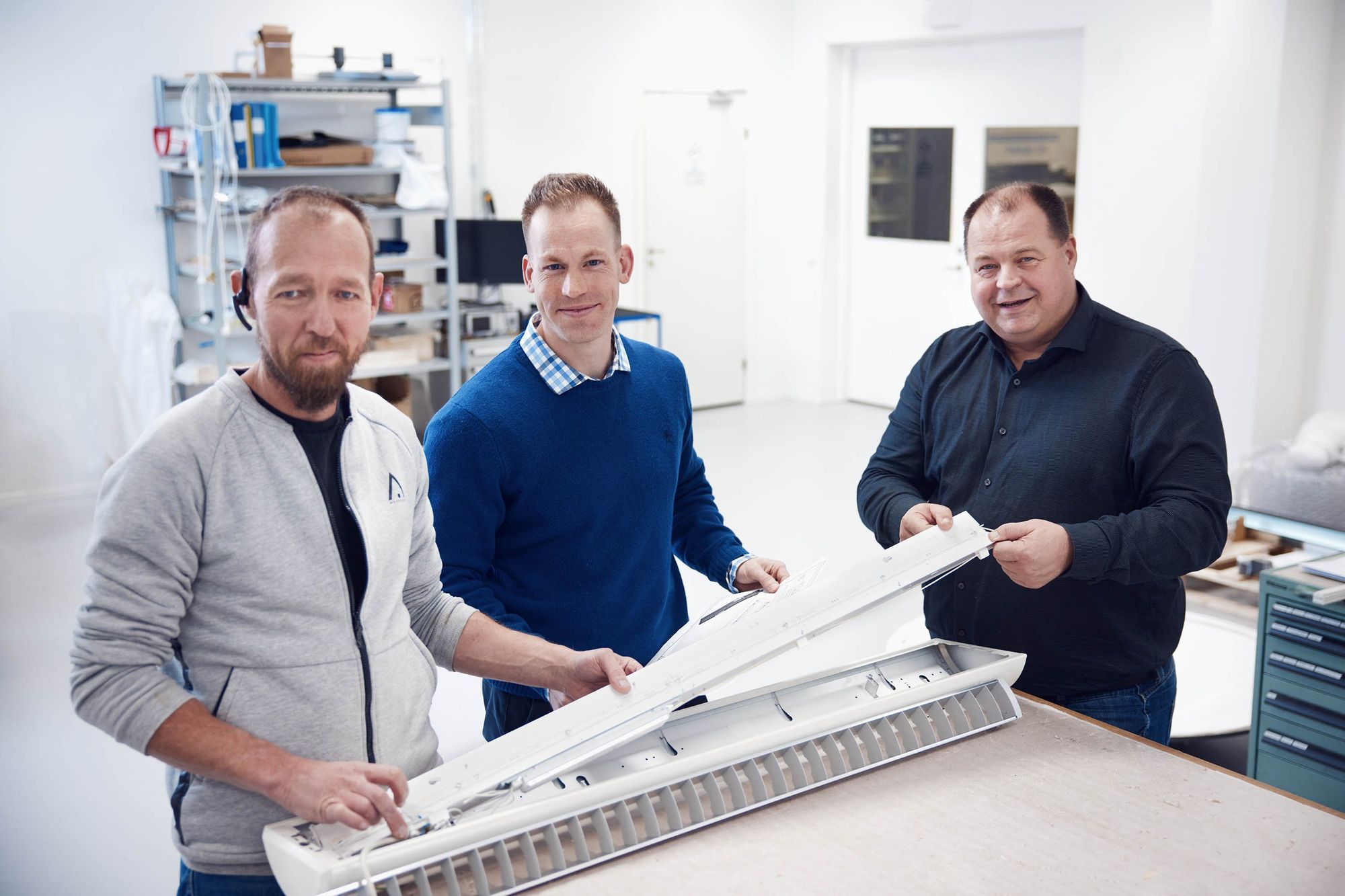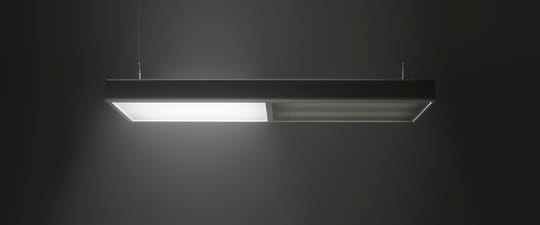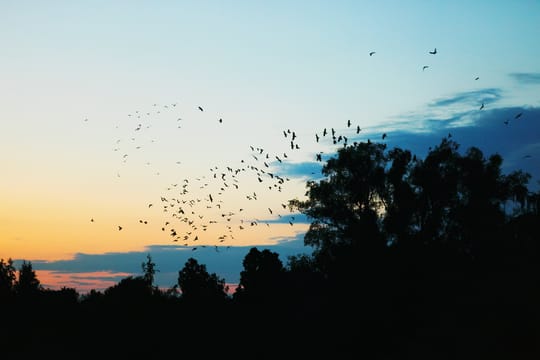
From the grave to the cradle - full circle for a luminaire
The concept of refurbishing and/or rebuilding old luminaires in order to save material and energy is a field that is rapidly growing. And sometimes, what an outdated fixture needs is some tender love and engineering skills to be able shine bright again. We have met with two of Fagerhult’s project managers, Johan Ericsson and Peter Eklund, that love a really tricky challenge. Preferably the ones that are absolutely impossible.
At Fagerhult there is a deeply rooted innovation culture that undoubtedly influences all aspects of the work. Possibly it springs from the founder Bertil Svensson’s mindset of solving problems with sometimes small means, but with a lot of curiosity and stubbornness. Even though sustainability was not a buzzword during Bertil’s days, durability and quality have always been cornerstones for the company. And the ongoing climate awareness has urged us all to challenge previous ways of thinking, and made us conscious of new fields possible for more long-lasting solutions.
For many years, BESPOKE LIGHTING SOLUTION (BLS), Fagerhult’s bespoke development department has developed unique luminaires and adapted solutions. They produce newly built luminaires, and refurbished and updated old fixtures - but has not previously had an outspoken sustainable agenda as motif from their clients. But the will and interest to refurbish and rebuild old luminaires is a sustainable trend that is increasing. A process in which yesterday’s design and technology are brought up to speed by todays advances, in order to meet the requirements of tomorrow.
 "It is more frequent now, than previously, that our clients has an outspoken will to save materials and energy in their projects." Johan Ericsson, project manager
"It is more frequent now, than previously, that our clients has an outspoken will to save materials and energy in their projects." Johan Ericsson, project manager
Rebuild, refurbish or repair?
Johan Ericsson and Peter Eklund are both project managers at BLS, where unusual questions and close to impossible solutions are a part of their everyday work. Together with their colleagues, they manage inquiries from all Fagerhult’s markets, regarding special developed lighting solutions for different projects. But what kind of projects choose to refurbish, instead of investing in a new luminaire – and why?
– There are many different reasons as to why a luminaire might need to be rebuilt or refurbished instead of just replaced, Johan Ericsson explains further. There are circumstances when the luminaire is a part of the aesthetics or the design of the premises and cannot be replaced or altered. In other cases the luminaire is a part of the construction, or is built in a way where it cannot be removed, just updated. In yet other cases, and that is more frequent now than previously, there is an outspoken will to save materials and energy – and make an environmental effort by updating the luminaires instead of buying newly produced ones.
– No matter what the background is, the main focus for us is – as always – to help the client to solve the problem at hand, says Peter Eklund. In order to do so we have different solutions for different situations. But all our solutions are carefully evaluated before suggested to the client, whether it is to refurbish, rebuild or develop a new luminaire. For us, the quality of the product and its outcome, is the most important part of the process. Apart from making our client satisfied, of course.
Safty first
No matter the project, safety and quality are the red thread combining all Fagerhult’s products. And the special projects are sure to be no exceptions. But to be able to guarantee a secure and comfortable lighting solution it needs to be tested. For refurbishment projects that could seem like a tricky part, but there are solutions even for this. Peter Eklund explains:
– A crucial issue is the CE-marking and testing in cases like these. The request from our Technical Centre is that we deliver a unit that is as close to a complete luminaire as possible. If we send loose parts that are assembled on site, we cannot guarantee the quality of the end product. But if the LED package is assembled and tested in our centre, as a unit, we can ensure that it works and keep up to standards even when it is inserted in the old luminaire body.
– In these cases, we have made calculations to ease the assembling part as much as we can, Johan Ericsson develops further. We produce the new light packages so that they fit into the old screw holes, to facilitate installation as much as possible.
 "No matter what the background is, the main focus for us is – as always – to help the client to solve the problem at hand." Peter Eklund, project manager
"No matter what the background is, the main focus for us is – as always – to help the client to solve the problem at hand." Peter Eklund, project manager
Old and used or old and gold?
In a very environmental aware era, it is easy to get caught up in the will of doing something good, when the outcome might in fact be the very opposite. Not all old luminaires are meant to live forever, some of them are outdated and is better to be recycled instead of refurbished. Johan Ericsson explains:
– We have already pinpointed a few luminaires in our range where we know that it is more efficient to actually buy a new luminaire, than refurbish an old. This because in the process of updating it, we need to add as much new material as in a new luminaire. Then we also have the aspect of lighting comfort. Some of the old design and materials are just not as good as today’s modern techniques. And I don’t think you should forget the aesthetic aspect, since people do have these fixtures in their working environment in some cases. Even if a luminaire can be ledified, it may not be certain that it is nice and cheeky to have in your office today.
– No matter the reasons, we always calculate and balance the effort and gain by rebuilding, refurbish or updating an existing luminaire compared to buying, or developing, a new one, says Peter Eklund. Our primary goal is always that the client is equipped with the best lighting solution for the project, and we want it to be safe and secure – whether it might be a refurbished luminaire or a new one. We would never do a refurbish project if it is not the best solution for the client and the environment. Some products are suitable and others not, and we have the competence to make that decision.
TEKST MARIA VÅRENIUS
FOTO PATRIK SVEDBERG

Read more about Re:Furbish
Re:Furbish is an initiative within Circular solutions – one of our four sustainability focus areas. By upgrading and improving existing luminaires, we can jointly create major benefits for the climate, the project’s economy, and future lighting comfort.
Les merRelaterte nyheter

Lukke ringen – og forlenge armaturens livssyklus
Konseptet med å gjenoppbygge gamle armaturer for å spare materiale og energi, blir stadig mer populært. Av og til trengs det bare litt kjærlighet og teknisk kunnskap for å få en utdatert armatur til å skinne igjen. Vi møtte Emma Hallman, Mathilda Holl og Andreas Ekslätt, teamet bak ReLight hos Fagerhult, for å snakke om utfordringene med å finne løsninger som tar gamle armaturer inn i fremtiden. Hos Fagerhult preges alt arbeid av en dypt forankret innovasjonskultur. Det kan hende det skyldes grunnleggeren Bertil Svenssons fokus på å løse utfordringer med til tider begrensede midler – og nysgjerrighet og engasjement. I motsetning til i dag er det ikke sikkert at bærekraft var et kjent begrep på den tiden. Men å bruke ressursene våre på en bevisst måte og ha som mål å levere høy kvalitet har alltid kjennetegnet Fagerhult. I dag har et nytt fokus på sirkularitet fått oss til å tenke nytt og gjort oss bevisste på å finne løsninger som varer lenge. Fagerhults Bespoke Lighting Solutions-avdeling (BLS) har utviklet unike armaturer og tilpassede løsninger i mange år. Derfor er vi godt kjent med å renovere og oppdatere gamle armaturer. Men målet om å gjenbruke og gjenoppbygge gamle armaturer for å redusere klimapåvirkningen har økt over tid. I denne prosessen blir eldre design og teknologi oppdatert ved hjelp av moderne løsninger for å dekke morgendagens krav. Sitat ReLight de gamle armaturene dine For ReLight-teamet hos Fagerhult finnes det ingen uvanlige spørsmål eller umulige løsninger. Hver eneste dag håndterer de forespørsler om spesialutviklede belysningsløsninger for prosjekter fra Fagerhults markeder. Prosessen er kompleks, men over tid har de funnet ut at enkelte prosjekter er perfekte for å gjenbruke gamle armaturer i stedet for å investere i nye. «For oss er kjernen i alle ReLight-prosjekter armaturens kvaliteter når det gjelder belysningskomfort, sikkerhet og estetikk. Ved forespørsel beregner vi også for å finne ut om – og hvor mye – vi kan redusere armaturens totale klimapåvirkning gjennom livssyklusen.», sier Emma Hallman. I ReLight er det en uttalt vilje til å spare materialer og energi, og til å gjøre en innsats for miljøet ved å oppdatere armaturene. Men ikke alle gamle armaturer kan få evig liv. Noen er utdaterte og bør resirkuleres i stedet for å renoveres. Img «Hvis omstendighetene ikke oppfyller kravene våre og armaturene ikke kan gjenoppbygges, går vi ikke videre med prosjektet. Vi går aldri på akkord med armaturens belysningskomfort, kvalitet, sikkerhet eller uttrykk hvis vi ikke kan oppnå en førsteklasses løsning», sier Emma Hallman. Hos Fagerhult er sikkerhet og kvalitet de røde trådene som forbinder alle produkter. Og ReLight er intet unntak. Gjennom hele prosessen er CE-merking og testing avgjørende faktorer. «For å sikre den totale kvaliteten er den oppdaterte armaturen CE-merket i sin helhet før levering. Vi ønsker også å gjøre installasjonen på stedet både smidig og rask, og det nye settet er så nær en komplett armatur som mulig», sier Andreas Ekslätt, Design Engineer.
New technology and intelligent control pave the way for tomorrow's outdoor lighting
All electric light is produced by - and for - humans. Research is now focusing on some important questions: Is our lighting of outdoor environments at the expense of other species? And how can we create a safe environment in balance with the ecosystem and with minimal light pollution? Outdoor lighting prolongs the day and is needed to provide a sense of safety and security, and to create attractive environments even when it is dark. However, light that is improperly directed, used at the wrong time of day, or lacks purpose can be considered light pollution. In addition, it is a waste of energy, and can negatively affect human well-being and animal habitats. “We are in the midst of a rapid development, where biodiversity is threatened,” says Henrik Sandqvist, Product and Application Manager Outdoor Lighting, at Fagerhult. “This happens largely because of humans, and lighting is a contributing factor. Some animals are attracted to the light and others avoid it, which can create an imbalance in the ecosystem.” HENRIK SANDQVIST, PRODUCT AND APPLICATION MANAGER OUTDOOR LIGHTING AT FAGERHULT Today, however, there are limited standards stipulating which lighting should be used where and when. Bioinclusive Lighting involves providing light that is good for people’s well-being and urban development – with as little impact on biodiversity as possible. “As a luminaire manufacturer, we are aware that we contribute to the increase in the amount of light. That is why we can also be part of the solution. We follow the research and guiding standards, and we listen to those who know more than we do. We want to stay ahead, and we always have Bioinclusive Lighting in mind in our product development. Our luminaire Evolume 1 has also been used in a joint study run by the University of Gävle and RISE, and we are happy to collaborate with others to find tomorrow’s solutions.” A darker light environment Around 80 percent of the world’s population cannot see a starry night sky. The reason is ‘skyglow’, which is caused by artificial light shining into the sky. The phenomenon is difficult to measure, but like other light pollution, it can have negative effects on humans, animals, and the environment. “Just as we turn off the lights when we leave a room, outdoor lighting should also be turned off or dimmed when people are no longer in the vicinity. Here it becomes very clear that the right light, in the right place, and at the right time plays an important role.” Henrik Sandqvist sitat Since lighting can affect species’ habitats, the ecosystem needs greater consideration in lighting design. When replacing or installing new lighting, it is important to ask: What is the purpose of the lighting? How does it affect the environment, people, animals and nature? “Our basic idea is that all lighting must have a purpose, and the right character and strength. The amount of light must be commensurate, and it must only directed where it is needed. Since the nature of light is governed by its spectral distribution, we want to avoid light in the lower wavelengths. The general recommendation is therefore to use as warm a light as possible. ANNIKA JÄGERBRAND (UNIVERSITY OF GÄVLE), MARIA NILSSON TENGELIN (RISE) AND HENRIK SANDQVIST (FAGERHULT). Adaptive lighting can also adjust the light intensity and spectral distribution, and time control and presence control enable lighting precisely when needed. “This is nothing new, and nothing we will solve today. But a good place to start is to use a lighting designer with good knowledge of outdoor lighting and who considers the whole when devising a solution. We will continue to focus on finding an inclusive approach to create light for people that is in balance with the ecosystem,” concludes Henrik Sandqvist. Product in focus: Evolume The Evolume luminaire series has good light comfort, and is now available with more options and colour temperatures: 2700K, 2200K and PC Amber as well as adaptive light. This allows the intensity, wavelength distribution, and light distribution to be adapted based on need, time, and presence, and with more consideration for animals and nature.
